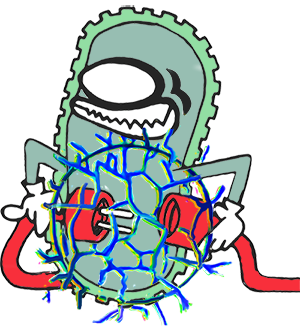Team:TU Delft-Leiden/Project/Life science/EET/cloning
From 2014.igem.org
Module Electron Transport – Cloning
In the wet lab we integrated the Electron Transport pathway of Shewanella oneidensis into Escherichia coli. Here you can find information with respect to cloning of the BioBricks for the Electron Transport pathway.
mtrCAB and mtrCAB-HIS
Our BioBricks BBa_K1316012 and BBa_K1316017 encode the mtrCAB genes under control of a weakened T7 promoter with the lac operator (T7 lacO). In addtion, BBa_K1316017 carries a histidine (HIS) tag at the 5' end of the coding sequence which makes it easier to purify MtrB during characterization experiments. The end constructs are visualized in figure 1 and 2.


Cloning Scheme
Making a BioBrick of the mtrCAB operon is quite challenging. First of all, the coding sequence of mtrCAB contains several illegal restrictions sites. Secondly, we need to have the operon under the regulation of an weakened T7 lacO promoter, which was found to be the best promoter to express mtrCAB in E. coli [1]. To get rid of the illegal restriction sites as well as implementing the T7 lacO promoter in our BioBricks BBa_K1316012 and href="http://parts.igem.org/Part:BBa_K1316017">BBa_K1316017 , we ended up having 5 pieces of DNA to be ligated into pSB1C3. To work efficiently, we used the Golden Gate Assembly to clone these BioBricks (see figure 3).

The Golden Gate primers were designed in a way that restriction with the BsaI enzyme resulted in a EcoRI overhang at the 3' end of the DNA and a SpeI overhang at the 5' of the DNA. In this way we were able to clone the DNA fragment into pSB1C3 by using EcoRI and SpeI. To construct the mtrCAB-HIS, the reverse primer of the last DNA part was designed in a way that a HIS tag was introduced at the C-terminus of the MtrB protein. However, there was no additional stop codon included in this primer. Therefore we do not characterize this BioBrick.
Later on, the mtrCAB BioBricks (BBa_K1316012 and BBa_K1316017) were introduced into pSB3K3, because it is a backbone with a much lower copy number than pSB1C3, and in the literature the mtrCAB genes were found to be quite toxic for E. coli.
ccmAH
Final constructs
The BioBrick constructed using the ccmAH gene cluster is BBa_K1316011 (figure 4).

Cloning Scheme
The BioBrick BBa_K1316011 was built up by amplifying the best performing promoter according to Goldbeck [1] and introducing it upstream the coding region of the ccmAH cluster of the Biobrick BBa_K917006 constructed by the iGEM team Edinburgh 2012, which was already BioBrick compatible.
A more graphical representation of the cloning strategy can be found on figure 5.

References
[1] C.P. Goldbeck, H.M. Jensen et al., “Tuning Promoter Strengths for Improved Synthesis and Function of Electron Conduits in Escherichia coli”, ACS Synth. Biol. 2, 150-159, 2013.
 "
"






